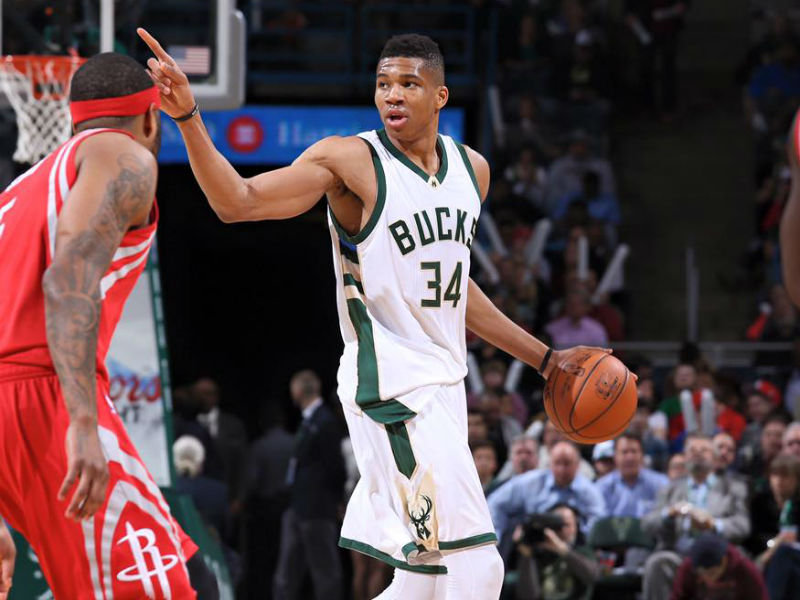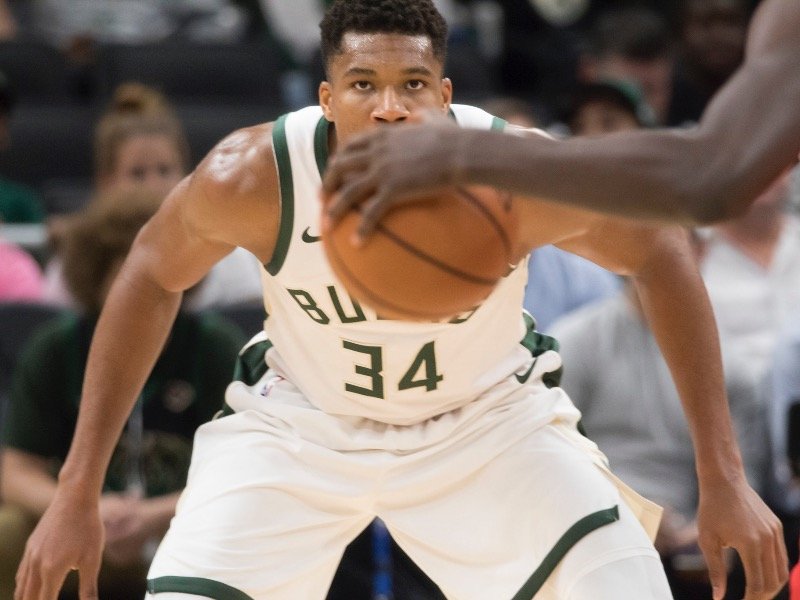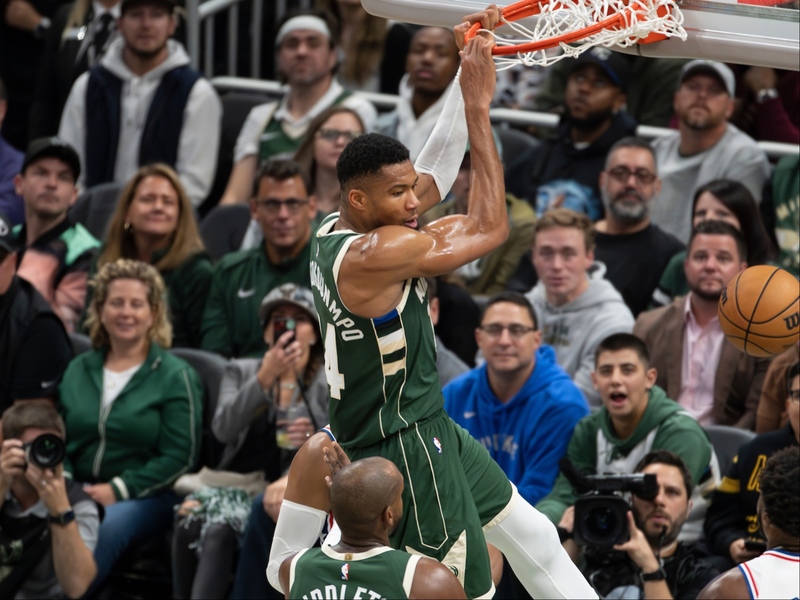This story has been updated since its March 31 publication because Giannis has no chill and went out and got himself another triple-double on Friday night.
Giannis Antetokounmpo as a point guard inspires great hope and even greater hyperbole.
He’s the tallest point guard in the NBA. The freakiest. The most unique. The most exciting. A triple-double machine. He’s got the highest ceiling (because what is it?) and the most potential. He’s going to change the game. He’s going to lead the Bucks to a championship. He’s going to grab that offensive rebound, take two dribbles the other way and dunk from the three-point line.
He’s the best point guard Milwaukee’s ever had. OK, since Oscar, right. But he’s the best they’ve had in a long, long, long time. (Apologies to Quinn Buckner, Sam Cassell, Nate Wolters and the rest.) If this is what he’s doing now, as a 21-year-old who’s played the position for less than two months on a young team still figuring itself out, think about what he could do next season, two seasons from now, five years from now. Would we have the parade on Wisconsin Avenue or State Street? Sorry, the mind wanders and wonders and walks out of reality when thinking about Point Giannis.
Honestly, though, he’s earned it – the pie-in-the-sky projections and title-high optimism. He’s elevated his overall game in ways we didn’t know he could, and he’s done it almost instantaneously – his learning curve as a playmaker was five double-digit assist nights, including three triple-doubles, in his first eight games on the job. He recorded another one in Friday's win over the Magic: 18 points, 11 boards, 11 dimes.
It's like Giannis flipped on the "Ball Outta Control" light switch. He’s been playing on another level lately.

In 22 games since the All-Star Break – the Bucks unofficially made him the primary ball-handler about a week after that – Antetokounmpo is averaging 18.1 points, 7.7 assists and 8.6 rebounds. Want to know who else is putting up those kinds of numbers this season? Russell Westbrook. These three guys are close but not quite there: LeBron James, Draymond Green and James Harden. And if you include Antetokounmpo’s comparatively miniscule 2.5 turnovers per game during that span, literally no one else is doing what he is doing on the basketball court right now.
The Bucks deserve some credit, too, for greenlighting this whole wacky, weird, wonderful experiment. And why not try it? The season went sour early and the team’s been out of realistic playoff contention for weeks. Milwaukee will likely finish at least 10 games below .500 and then get another lottery pick in the draft (might they trade this one?), before beginning another summer of down payments toward the Owning of the Future.
And, after head coach Jason Kidd made the announcement on Tuesday, we know that Antetokounmpo will be the one "handling the ball" for the Bucks heading into training camp and next season. Kidd was careful not to, himself, call Antetokounmpo a point guard – "you can call him point guard, point forward, point center," he said – preferring to use the ball-handler designation, but functionally it’s clear: Giannis Antetokounmpo, the 6-foot-11 Greek Freak, will be the Bucks’ starting point guard next year.
Given the statistics he’s messing around with and what we’ve seen so far, that seems like a great idea. But, as with any major decision, important questions need to be asked. So, here are seven questions about the Point Giannis plan:
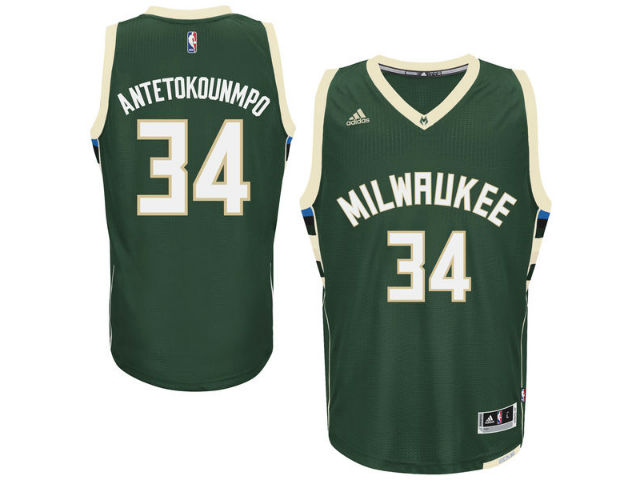
1. Why did it take so long to make the move?
Back in training camp before this season started, Kidd spoke about using Antetokounmpo at point guard. He did so in the preseason, just a little bit, but basketball shockwaves weren’t generated, the earth continued to spin on its axis and Antetokounmpo went back to playing forward when the season started. He stayed at that position, for the most part, for the next four months, as the Bucks struggled and alternated their starting point guard four times between a perplexing young player (Michael Carter-Williams) and a veteran that probably isn’t part of the team’s long-term plans (O.J. Mayo). Antetokounmpo, obviously, has thrived since taking the playmaking reigns – and, incidentally, both Carter-Williams and Mayo were lost for the season due to injuries in early March – but the question is, why did it take Kidd so long to give him the opportunity?
The head coach knows his players more intimately than anyone else and, as one of the greatest point guards in NBA history, presumably Kidd is well-equipped to recognize talent and potential at the position. If you’re watching your team on the practice court every day, and he’s ultimately this sublimely successful at it, how do you not see Antetokounmpo as your point guard earlier than two-thirds of the way through a capsized season? Possibly, Kidd knew Antetokounmpo wasn’t yet ready for the responsibility; possibly, he wanted to wait until fellow 21-year-old face of the franchise and running mate Jabari Parker was hitting his stride, which happened around the same time; perhaps the switch wasn’t urgently needed with MCW and Mayo healthy. Regardless of all that, it took too long. Fans and media can only speculate about players’ abilities; coaches are supposed to know their strengths and weaknesses and put them in the best position to succeed.
2. Why make the announcement now? Why make it at all?
As noted before, the Bucks’ season is effectively over – in terms of record, not player development, of course – and it’s hard to see what the team or Antetokounmpo gains by proclaiming him the point guard of next year with seven games left in this year. Sure, maybe it gives Giannis extra confidence to know he’s won the job, but isn’t that a conversation that could have happened privately between coach and player? This isn’t a head coach who is overly divulging with the media. That’s perfectly fine; many are that way, and with the stakes so high, why wouldn’t he be cagey? But Antetokounmpo has already been playing the position, so what’s the significance of publicly applying a label?
Kidd has now cycled through Brandon Knight, Carter-Williams, Mayo and Antetokounmpo at point guard in 13 months, and making another big decision at the most important position doesn’t seem like something that needed to be so urgent. Plus, though an underachieving and injured player probably isn’t drawing a lot of interest anyway, this further damages MCW’s trade value, as teams now know the Bucks consider him at most a backup. The NBA is an ever-changing league, especially with personnel in the summer; players can suddenly become available and unexpected things can happen. Strategically, why tell the other 29 clubs you’ve firmly committed to anything in the future before the offseason has even begun?
3. Is this a gimmick or a long-term plan?
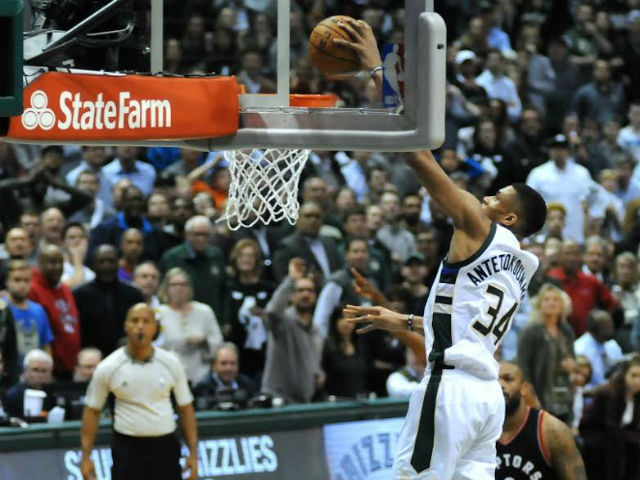
Antetokounmpo has proven to be really, really good at some aspects of playing the point. He’s also proven to completely reinvent other aspects. He can see over the entire defense; almost at will, he can either back down smaller defenders or blow past taller guys to get into the lane; he can start breaks immediately after grabbing a defensive rebound and pushing up the court; his field-goal percentage from less than five feet is 64.3, as his size helps him finish at the basket better than most players.
But is this 6-foot-11 point prodigy just a 20-game novelty, or something sustainable? Can the things he does differently than traditional 1-guards continue to be different in a good way? Antetokounmpo's turnover rate has been incredibly low so far; that’s an area in which Carter-Williams and almost all young point guards struggle. But, like when a young pitcher is dominant in his debut but less effective once hitters adjust to him, will the rest of the league at some point figure out how to play him? It’s hard to imagine any poor shooter, even one as physically gifted as Antetokounmpo, continuing to succeed in a league that’s all about shooting.
4. How will Giannis deal with smaller point guards defending him?
Related to the above question, opponents have lately taken to playing their point guard on Antetokounmpo on defense, regardless of the matchups elsewhere. Small, quick, pesky players, poking and prodding at the ball from a low stance, their heads reaching Giannis’ chest. He appeared to have a lot of trouble with Phoenix’s Brandon Knight on Wednesday – Antetokounmpo finished with 10 points, six assists and three rebounds in 32 quiet minutes – and that surely is part of the blueprint other teams see to defending the Greek Freak.
His assist-to-turnover ratio since the All-Star Break is 3.08, which for the season would be good enough for sixth in the league. Having his pocket picked or being pressured into throwing the ball away a couple times a game, though, would quickly balloon that fine figure. For now, it seems, opponents will try to get up and harass him early in the half-court far away from the basket, but then sag off and force him to shoot once the Bucks are into their offense. How will Antetokounmpo respond?
5. Do we have to come up with another nickname for the Greek Freak now?
No. During Wednesday’s broadcast, Gus Johnson first floated "Magic Giannis-son," because he’s a very tall point guard, and later called him "The Natural." Unneeded. He’s already got a great nickname.
6. Do the Bucks still need to find another point guard?

There seems to be a lot of debate and difference of opinion on this one. Carter-Williams underwent hip surgery and will be out until summer, at which time he will begin working his way toward being the backup point guard. Meanwhile, Tyler Ennis, who had barely been used at all until a few weeks ago, has performed very well as a methodical, low-mistake playmaker. In Friday's win, Ennis scored a career-high 15 points, making 2 of 3 three-pointers, while sharing the backcourt backing-up with Greivis Vasquez, who's an unrestricted free agent at the end of the season.
Mayo and Jerryd Bayless are also free-agent guards. They probably are disposable, even as veteran mentor types and even though Kidd really likes Bayless. At the right price, one could possibly return, but don’t count on it. As for Carter-Williams and Ennis, they are both ideally suited to be backups anyway. With Antetokounmpo starting, either MCW or Ennis could be the primary backup and one of the two would also be able to play alongside Giannis as a supplementary ball-handler and a better matchup on defense. Carter-Williams played well off the bench this season, especially when that was his clearly defined role; Ennis has been a revelation, at times, as the composed, unselfish leader of the second unit. The Bucks might be set at point guard, though only Ennis can shoot.
7. Does Point Giannis make the Bucks a better team?
Aye, there’s the rub. Since the All-Star Break, with Point Giannis leading the offense, Milwaukee has gone 10-12, a .455 winning percentage that’s better than their season mark of .413 but still not good. Certainly, big changes take time to pay off. But the concerning thing is that the Bucks have still struggled with Antetokounmpo playing out of his mind, as well as with Parker coming on. The hope is that the two, along with Khris Middleton and the rest of the young Bucks, continue to make strides toward stardom.
It’s titillating (yes, titillating) to think there will be an entire offseason for Antetokounmpo to learn his new, vital position and for coaches to design creative ways to make his talents even more dynamic in the offense. Point Giannis is crazy good fun to watch. We’ll see at this time next year whether it’s actually meant anything important for the team.
Born in Milwaukee but a product of Shorewood High School (go ‘Hounds!) and Northwestern University (go ‘Cats!), Jimmy never knew the schoolboy bliss of cheering for a winning football, basketball or baseball team. So he ditched being a fan in order to cover sports professionally - occasionally objectively, always passionately. He's lived in Chicago, New York and Dallas, but now resides again in his beloved Brew City and is an ardent attacker of the notorious Milwaukee Inferiority Complex.
After interning at print publications like Birds and Blooms (official motto: "America's #1 backyard birding and gardening magazine!"), Sports Illustrated (unofficial motto: "Subscribe and save up to 90% off the cover price!") and The Dallas Morning News (a newspaper!), Jimmy worked for web outlets like CBSSports.com, where he was a Packers beat reporter, and FOX Sports Wisconsin, where he managed digital content. He's a proponent and frequent user of em dashes, parenthetical asides, descriptive appositives and, really, anything that makes his sentences longer and more needlessly complex.
Jimmy appreciates references to late '90s Brewers and Bucks players and is the curator of the unofficial John Jaha Hall of Fame. He also enjoys running, biking and soccer, but isn't too annoying about them. He writes about sports - both mainstream and unconventional - and non-sports, including history, music, food, art and even golf (just kidding!), and welcomes reader suggestions for off-the-beaten-path story ideas.

